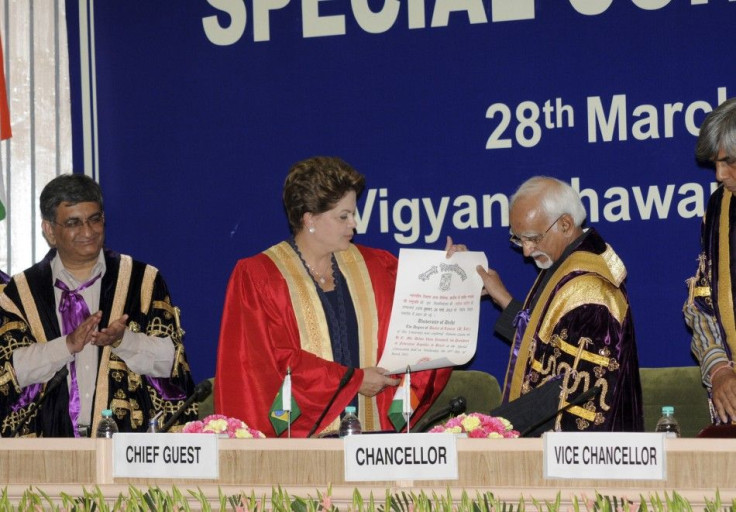BRICS: A Profile Of The World's Emerging Powerhouses

As the BRICS nations -- Brazil, Russia, India, China and South Africa – prepare to meet for a summit in New Delhi starting Thursday, now is an ideal opportunity to examine the economies of these emerging powerhouses.
Leaders of the five countries – representing about half the world's population – will discuss a number of topics including possible formation of a joint development bank, closer integration of their respective stock exchanges, energy security and ongoing tensions in the Middle East.
Coined in 2001 by Jim O’Neill, an economist at Goldman Sachs (South Africa joined the bloc in 2010), the phrase “BRICS” appeared to herald the rise of new powers in a radically changed economic and financial landscape.
The BRICS are likely to keep outpacing the developed world in terms of economic growth.
O’Neill forecasts that within three years, the combined gross domestic product of the BRICS will exceed that of the United Stated, while China itself will become the world's biggest economy by 2027.
India is expected to replace China by the year 2050.
Similarly, Standard Chartered Bank also forecast that China will supplant the United States as the world’s No. 1 economy by 2020 (more than quadrupling from $5.7 trillion in 2010 to $24.6 trillion), edging out the runner-up's $23.3 trillion. India is expected to occupy the third slot, at $9.6 trillion.
Still, the BRICS face some significant challenges, not the least of which are slowing economic growth in the euro zone and the United States, two key customers and trade partners for the five-member bloc.
Even if China’s economy grows larger than that of United States, the fact the Chinese population is more than four times bigger means that, on a per capita basis, the average worker in China will still be poorer than his American and European counterparts.
For example, Euromonitor Global Markets Research estimated that in 2020, the annual disposable income per capita will amount to $5,807 in BRICS countries, compared with $31,050 in the euro zone.
The ERS International Macroeconomic Data Set has forecast that by 2020, the GDP per capita in the U.S. will amount to about $49,500, dwarfing the $6,000 estimate for China.
Here is a summary of each member of BRICS:*
BRAZIL
Resource-rich Brazil is the biggest economy in South America and No. 6 in the world. It enjoys record-low unemployment and newfound prestige as a dominant geopolitical force. However, there are some black clouds over Rio -- inflation is rising, estimated at about 5.28 percent this year, and the central bank is cutting interest rates in anticipation of a global slowdown. Although Brazil has embarked on a huge infrastructure-building program, concerns persist about household debt, high rates of violent crime in major cities and a widening wealth gap.
2011 GDP growth: 2.7 percent 2012 GDP growth, estimated: 3.2 percent (central bank survey) GDP: $2.09 trillion (2010) Population: 195 million Percent of population in poverty: 21.4 percent (2009) Literacy rate: 90 percent
RUSSIA
Amid growing political discontent with President-elect Vladimir Putin, rampant corruption, an overdependence on the energy sector and diminishing population, Russia also faces a litany of challenges to its long-term economic growth. On the brighter side, Russia enjoys growing consumer demand and very modest public debt of only 12 percent of GDP.
2011 GDP growth: 4.3 percent 2012 GDP growth, estimated: 3.5 percent GDP: $1.48 trillion (2010) Population: 142 million Percent of population in poverty: 11.1 percent (2006) Literacy rate: 100 percent
INDIA
India could become the world’s biggest economy by the middle of the 21st century, but it must contend with a multitude of problems, including poor infrastructure, endemic political corruption and a rapidly expanding population.
2011 GDP growth: 7.8 percent 2012 GDP growth, estimated: 7.6 percent (Commodity Online) GDP: $1.73 trillion (2010) Population: 1.17 billion Percent of population in poverty: 37.2 percent (2005) Literacy rate: 63 percent
CHINA
The world’s economic growth engine is still delivering torrid GDP growth, but worries abound. China must contend with a sharp reduction in real estate construction activity following a period of excess, while other nations, particularly the United States, are pressuring the Chinese to allow the value of its yuan currency to rise from artificially depressed levels. Continued weakness in the euro zone is also likely to dampen China’s near-term economic prospects.
2011 GDP growth: 9.2 percent 2012 GDP growth, estimated: 8.3 percent (Standard & Poor's) GDP: $5.93 trillion (2010) Population: 1.34 billion Percent of population in poverty: 2.8 percent (2004) Literacy rate: 94 percent
SOUTH AFRICAThe newest member of BRICS, South Africa is overly dependent on its natural resources and mining sectors, which in turn have been hurt by the country's exposure to weak European and U.S. markets. Infrastructure remains poor, and 20 years after the end of apartheid, about half of the black population remains poor and unemployed.
2011 GDP growth: 2.9 percent 2012 GDP growth, estimated: 2.8 percent (Citigroup) GDP: $364 brillion (2010) Population: 50 million Percent of population in poverty: 23 percent (2006) Literacy rate: 89 percent
*Data from World Bank, unless otherwise noted.
© Copyright IBTimes 2024. All rights reserved.











